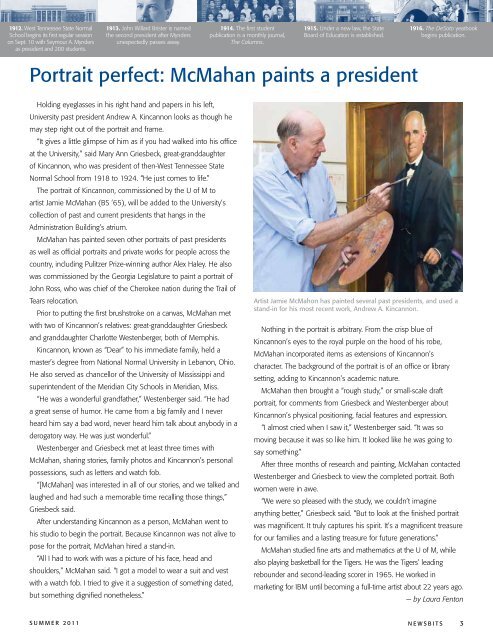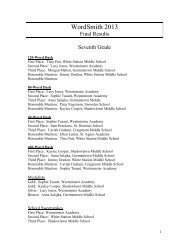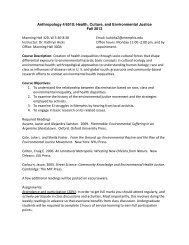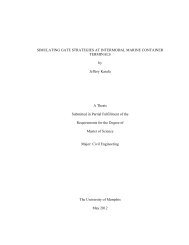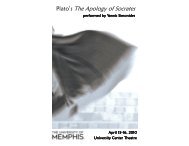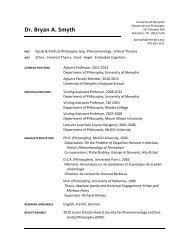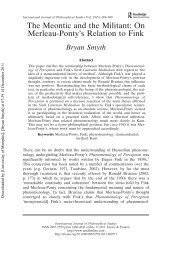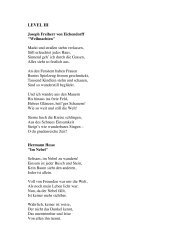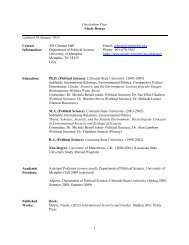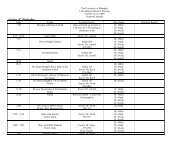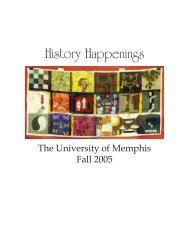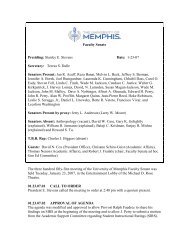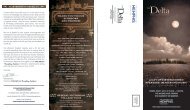By Greg Russell - University of Memphis
By Greg Russell - University of Memphis
By Greg Russell - University of Memphis
You also want an ePaper? Increase the reach of your titles
YUMPU automatically turns print PDFs into web optimized ePapers that Google loves.
1912. West Tennessee State Normal<br />
School begins its first regular session<br />
on Sept. 10 with Seymour A. Mynders<br />
as president and 200 students.<br />
1913. John Willard Brister is named<br />
the second president after Mynders<br />
unexpectedly passes away.<br />
1914. The first student<br />
publication is a monthly journal,<br />
The Columns.<br />
1915. Under a new law, the State<br />
Board <strong>of</strong> Education is established.<br />
Portrait perfect: McMahan paints a president<br />
Holding eyeglasses in his right hand and papers in his left,<br />
<strong>University</strong> past president Andrew A. Kincannon looks as though he<br />
may step right out <strong>of</strong> the portrait and frame.<br />
“It gives a little glimpse <strong>of</strong> him as if you had walked into his <strong>of</strong>fice<br />
at the <strong>University</strong>,” said Mary Ann Griesbeck, great-granddaughter<br />
<strong>of</strong> Kincannon, who was president <strong>of</strong> then-West Tennessee State<br />
Normal School from 1918 to 1924. “He just comes to life.”<br />
The portrait <strong>of</strong> Kincannon, commissioned by the U <strong>of</strong> M to<br />
artist Jamie McMahan (BS ’65), will be added to the <strong>University</strong>’s<br />
collection <strong>of</strong> past and current presidents that hangs in the<br />
Administration Building’s atrium.<br />
McMahan has painted seven other portraits <strong>of</strong> past presidents<br />
as well as <strong>of</strong>ficial portraits and private works for people across the<br />
country, including Pulitzer Prize-winning author Alex Haley. He also<br />
was commissioned by the Georgia Legislature to paint a portrait <strong>of</strong><br />
John Ross, who was chief <strong>of</strong> the Cherokee nation during the Trail <strong>of</strong><br />
Tears relocation.<br />
Prior to putting the first brushstroke on a canvas, McMahan met<br />
with two <strong>of</strong> Kincannon’s relatives: great-granddaughter Griesbeck<br />
and granddaughter Charlotte Westenberger, both <strong>of</strong> <strong>Memphis</strong>.<br />
Kincannon, known as “Dear” to his immediate family, held a<br />
master’s degree from National Normal <strong>University</strong> in Lebanon, Ohio.<br />
He also served as chancellor <strong>of</strong> the <strong>University</strong> <strong>of</strong> Mississippi and<br />
superintendent <strong>of</strong> the Meridian City Schools in Meridian, Miss.<br />
“He was a wonderful grandfather,” Westenberger said. “He had<br />
a great sense <strong>of</strong> humor. He came from a big family and I never<br />
heard him say a bad word, never heard him talk about anybody in a<br />
derogatory way. He was just wonderful.”<br />
Westenberger and Griesbeck met at least three times with<br />
McMahan, sharing stories, family photos and Kincannon’s personal<br />
possessions, such as letters and watch fob.<br />
“[McMahan] was interested in all <strong>of</strong> our stories, and we talked and<br />
laughed and had such a memorable time recalling those things,”<br />
Griesbeck said.<br />
After understanding Kincannon as a person, McMahan went to<br />
his studio to begin the portrait. Because Kincannon was not alive to<br />
pose for the portrait, McMahan hired a stand-in.<br />
“All I had to work with was a picture <strong>of</strong> his face, head and<br />
shoulders,” McMahan said. “I got a model to wear a suit and vest<br />
with a watch fob. I tried to give it a suggestion <strong>of</strong> something dated,<br />
but something dignified nonetheless.”<br />
1916. The DeSoto yearbook<br />
begins publication.<br />
Artist Jamie McMahon has painted several past presidents, and used a<br />
stand-in for his most recent work, Andrew A. Kincannon.<br />
Nothing in the portrait is arbitrary. From the crisp blue <strong>of</strong><br />
Kincannon’s eyes to the royal purple on the hood <strong>of</strong> his robe,<br />
McMahan incorporated items as extensions <strong>of</strong> Kincannon’s<br />
character. The background <strong>of</strong> the portrait is <strong>of</strong> an <strong>of</strong>fice or library<br />
setting, adding to Kincannon’s academic nature.<br />
McMahan then brought a “rough study,” or small-scale draft<br />
portrait, for comments from Griesbeck and Westenberger about<br />
Kincannon’s physical positioning, facial features and expression.<br />
“I almost cried when I saw it,” Westenberger said. “It was so<br />
moving because it was so like him. It looked like he was going to<br />
say something.”<br />
After three months <strong>of</strong> research and painting, McMahan contacted<br />
Westenberger and Griesbeck to view the completed portrait. Both<br />
women were in awe.<br />
“We were so pleased with the study, we couldn’t imagine<br />
anything better,” Griesbeck said. “But to look at the finished portrait<br />
was magnificent. It truly captures his spirit. It’s a magnificent treasure<br />
for our families and a lasting treasure for future generations.”<br />
McMahan studied fine arts and mathematics at the U <strong>of</strong> M, while<br />
also playing basketball for the Tigers. He was the Tigers’ leading<br />
rebounder and second-leading scorer in 1965. He worked in<br />
marketing for IBM until becoming a full-time artist about 22 years ago.<br />
— by Laura Fenton<br />
SUMMER 2011 NEWSBITS 3


